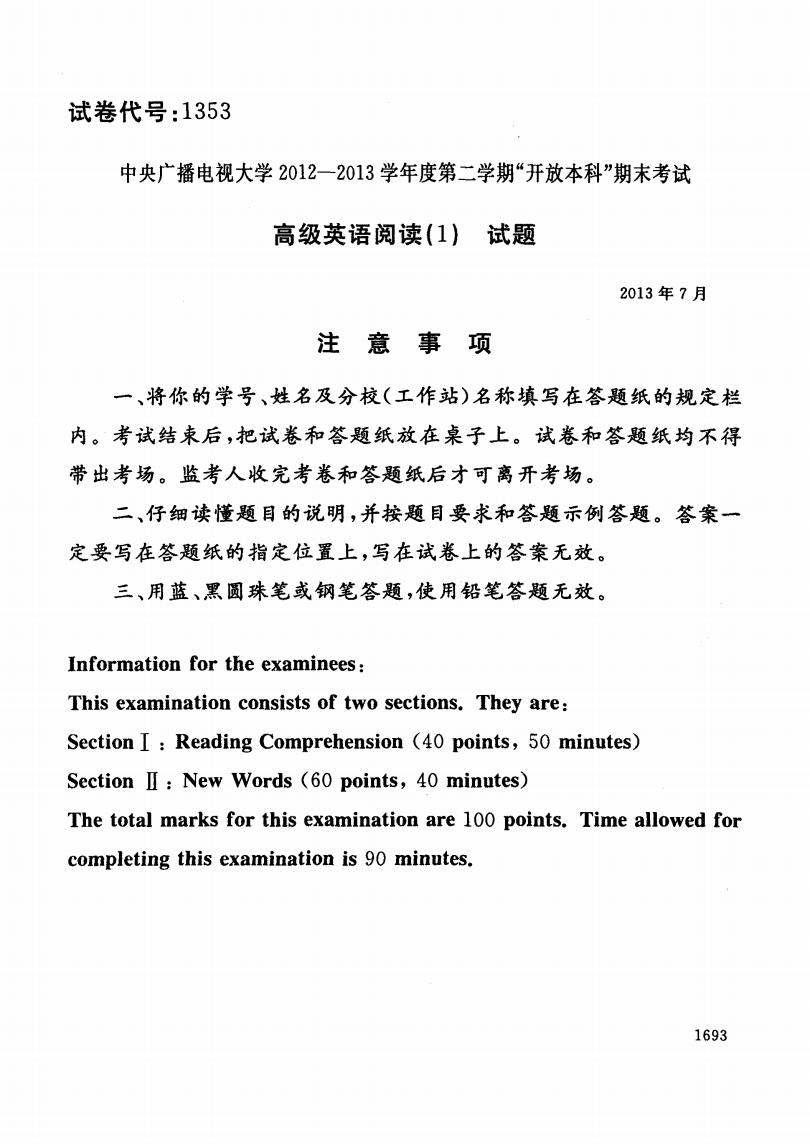
试卷代号:1353 中央广播电视大学2012一2013学年度第二学期“开放本科”期末考试 高级英语阅读(1)试题 2013年7月 注意事项 一、将你的学号、姓名及分校(工作站)名称填写在答题纸的规定栏 内。考试结束后,把试卷和答题纸放在桌子上。试卷和答题纸均不得 带出考场。监考人收完考卷和答题纸后才可离开考场。 二、仔细读懂题目的说明,并按题目要求和答题示例答题。答案一 定要写在答题纸的指定位置上,写在试卷上的答案无效。 三、用蓝、黑圆珠笔或钢笔答题,使用铅笔答题无效。 Information for the examinees: This examination consists of two sections.They are: Section I Reading Comprehension (40 points,50 minutes) SectionⅡ:New Words(60 points,40 minutes) The total marks for this examination are 100 points.Time allowed for completing this examination is 90 minutes. 1693
试卷代号 中央广播电视大学 3学年度第二学期"开放本科"期未考试 高级英语离读 )试题 2013 年7 注意事项 一、将你的学号、姓名及分校〈工作站)名称填写在答题纸的规定糕 内。考试结束后,把试卷和答题纸就在桌子上。试卷和答题纸均不得 带出考场。监考人状完考卷和答题纸后才可离开考场。 二、仔细读懂题目的说明,并按题目要求和答题示例答题。答案… 定要写在答题纸的指定位置上,写在试卷上的答案无效。 三、用蓝、黑圆珠笔,成钢笔答题,使用铅笔答题元效。 Information for the examinees: This examination consists of two sections. They are: Section I : Reading Comprehension (40 points, 50 minutes) Section IT : New Words (60 points, 40 minutes) The total marks for this examination are 100 points. Time allowed for completing this examination is 90 minutes. 1693
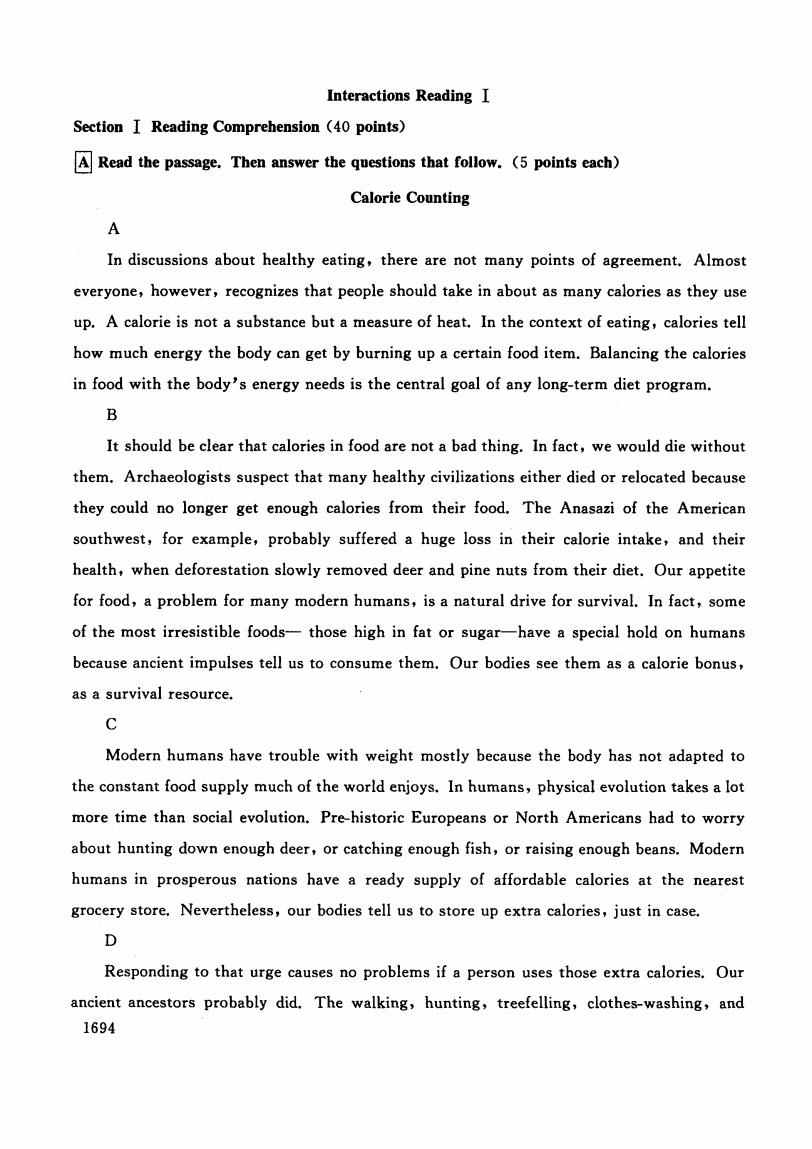
Interactions Reading I Section I Reading Comprehension (40 points) A Read the passage.Then answer the questions that follow.(5 points each) Calorie Counting A In discussions about healthy eating,there are not many points of agreement.Almost everyone,however,recognizes that people should take in about as many calories as they use up.A calorie is not a substance but a measure of heat.In the context of eating,calories tell how much energy the body can get by burning up a certain food item.Balancing the calories in food with the body's energy needs is the central goal of any long-term diet program. B It should be clear that calories in food are not a bad thing.In fact,we would die without them.Archaeologists suspect that many healthy civilizations either died or relocated because they could no longer get enough calories from their food.The Anasazi of the American southwest,for example,probably suffered a huge loss in their calorie intake,and their health,when deforestation slowly removed deer and pine nuts from their diet.Our appetite for food,a problem for many modern humans,is a natural drive for survival.In fact,some of the most irresistible foods-those high in fat or sugar-have a special hold on humans because ancient impulses tell us to consume them.Our bodies see them as a calorie bonus, as a survival resource. C Modern humans have trouble with weight mostly because the body has not adapted to the constant food supply much of the world enjoys.In humans,physical evolution takes a lot more time than social evolution.Pre-historic Europeans or North Americans had to worry about hunting down enough deer,or catching enough fish,or raising enough beans.Modern humans in prosperous nations have a ready supply of affordable calories at the nearest grocery store.Nevertheless,our bodies tell us to store up extra calories,just in case. D Responding to that urge causes no problems if a person uses those extra calories.Our ancient ancestors probably did.The walking,hunting,treefelling,clothes-washing,and 1694
Interactions Reading I 配tion I Reading Comprehension (40 points) the passa俱Then answer 伽questions 伽t follow. (5 酬nts each) Calorie Counting A In discussions about healthy eating , there are not many points of agreement. Almost everyone , however, recognizes that people should take in about as many calories as they use up. A calorie is not a substance but a measure of heat. In the context of eating , calories tell how much energy the body can get by burning up a certain food item. Balancing the calories in food with the body's energy needs is the central goal of any long-term diet program. B It should be clear that calories in food are not a bad thing. In fact , we would die without them. Archaeologists suspect that many healthy civilizations either died or relocated because they could no longer get enough calories from their food. The Anasazi of the American southwest , for example , probably suffered a huge loss in their calorie intake , and their health , when deforestation slowly removed deer and pine nuts from their diet. Our appetite for food , a problem for many modern humans, is a natural drive for survival. In fact , some of the most irresistible foods- those high in fat or sugar-have a special hold on humans because ancient impulses tell us to consume them. Our bodies see them as a calorie bonus, as a survival resource. C Modern humans have trouble with weight mostly because the body has not adapted to the constant food supply much of the world enjoys. In humans, physical evolution takes a lot more time than social evolution. Pre-historic Europeans or North Americans had to worry about hunting down enough deer, or catching enough fish , or raising enough beans. Modern humans in prosperous nations have a ready supply of affordable calories at the nearest grocery store. Nevertheless, our bodies tell us to store up extra calories, just in case. D Responding to that urge causes no problems if a person uses those extra calories. Our ancient ancestors probably did. The walking , hunting , treefe11ing, clothes-washing , and 1694
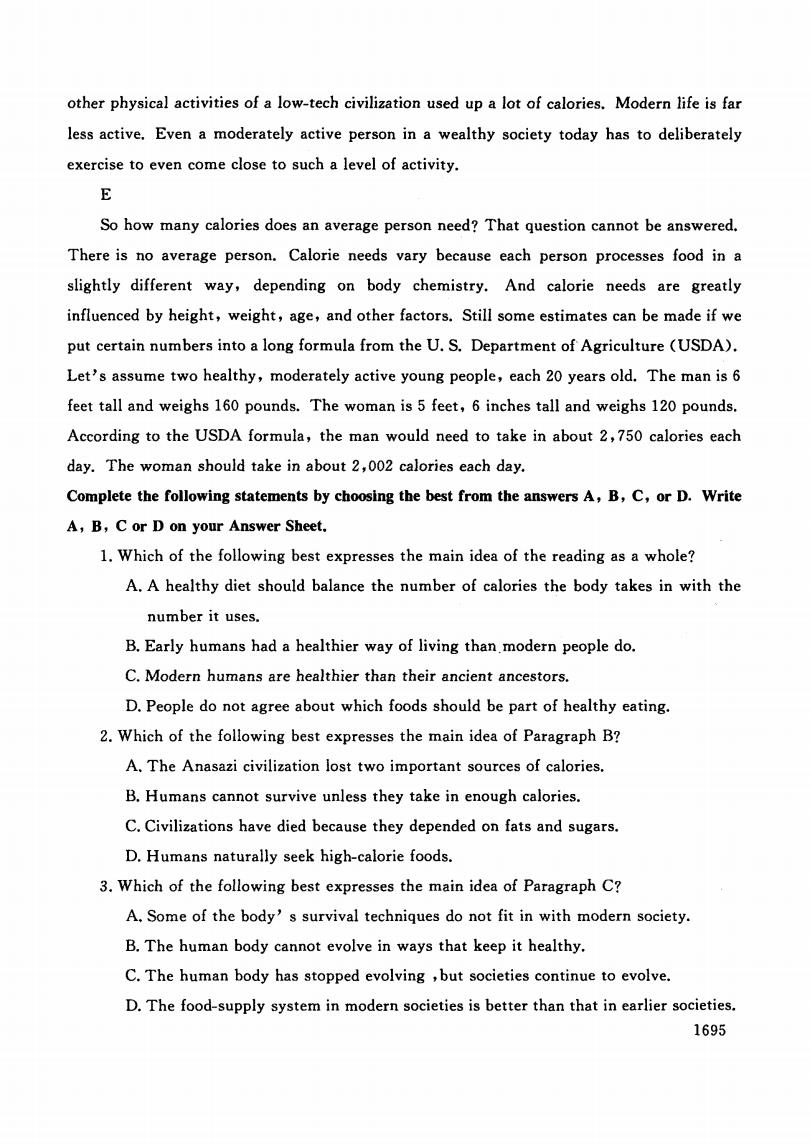
other physical activities of a low-tech civilization used up a lot of calories.Modern life is far less active.Even a moderately active person in a wealthy society today has to deliberately exercise to even come close to such a level of activity. E So how many calories does an average person need?That question cannot be answered. There is no average person.Calorie needs vary because each person processes food in a slightly different way,depending on body chemistry.And calorie needs are greatly influenced by height,weight,age,and other factors.Still some estimates can be made if we put certain numbers into a long formula from the U.S.Department of Agriculture (USDA). Let's assume two healthy,moderately active young people,each 20 years old.The man is 6 feet tall and weighs 160 pounds.The woman is 5 feet,6 inches tall and weighs 120 pounds. According to the USDA formula,the man would need to take in about 2,750 calories each day.The woman should take in about 2,002 calories each day. Complete the following statements by choosing the best from the answers A,B,C,or D.Write A,B,C or D on your Answer Sheet. 1.Which of the following best expresses the main idea of the reading as a whole? A.A healthy diet should balance the number of calories the body takes in with the number it uses. B.Early humans had a healthier way of living than.modern people do. C.Modern humans are healthier than their ancient ancestors. D.People do not agree about which foods should be part of healthy eating. 2.Which of the following best expresses the main idea of Paragraph B? A.The Anasazi civilization lost two important sources of calories. B.Humans cannot survive unless they take in enough calories. C.Civilizations have died because they depended on fats and sugars. D.Humans naturally seek high-calorie foods. 3.Which of the following best expresses the main idea of Paragraph C? A.Some of the body's survival techniques do not fit in with modern society. B.The human body cannot evolve in ways that keep it healthy. C.The human body has stopped evolving but societies continue to evolve. D.The food-supply system in modern societies is better than that in earlier societies. 1695
other physical activities of a low-tech civilization used up a lot of calories. Modern life is far less active. Even a moderately active person in a wealthy society today has to deliberately exercise to even come close to such a level of activity. E so how many calories does an average person need? 头at question cannot be answered. There is no average pεrson. Calorie needs 亨ary hec蛊use each person processes food in a slightly different way, depending on body chemistry. And calorie needs are greatly influenced by height, weight , age , and other factors. Still some estimates can be made if we put certain numbers into a long formula from the U. S. Department ofAgriculture (USDA). Let's assume two healthy , moderately active young people , each 20 years old. The man is 6 feet tall and weighs 160 pounds. The woman is 5 feet , 6 inches tall and weighs 120 pounds. According to the USDA formula , the man would need to take in about 2 ,750 calories each day. The woman should take in about 2,002 calories each day. Complete the following statements by ch 回ng the best from the answers A, B, C, or D. Write A, B, C or D on your Answer Sheet. 1. Which of the following best expresses the main idea of the reading as a whole? A. A healthy diet should balance the number of calories the body takes in with the number it uses. B. Early humans had a healthier way of living than.modern people do. C.Modεrn humans are healthi 住an their ancient ancestors. D. People do not agree about which foods should be part of healthy eating. 2. Which of the following best expresses the main idea of Paragraph B? A. The Anasazi civilization lost two important sources of calories. B. Humans cannot survive unless they take in enough calories. C. Civilizations have died because they depended on fats and sugars. D. Humans naturally seek high-calorie foods. 3. Which of the following best express军s the main idea of Paragraph C? A. Some of the body' s su主vival techniqu号s do not fit in with modern sociξty. B. The human body cannot evolve in ways that keep it healthy. C. The human body has stopped evolving ,but societies continue to evolve. D. The food-supply system in modern societies is better than that in earlier societies. 1695

4.Why does the author mention walking in Paragraph D? A.It is the most important activity of humans in low-tech societies. B.It is the most important source of exercise for modern humans. C.As an example of the activities common in low-tech societies. D.As an example of the activities that are not part of life in modern societies. 5.Which of the following best expresses the main idea of Paragraph E? A.There is no way to estimate how many calories a person should take in. B.Personal traits like weight,height,and age have to be considered in any calculation of calorie needs. C.Men need to take in more calories each day than women need to take in. D.The USDA has a formula for figuring out how many calories a person should take in every day. BRead the passage.Then answer the questions that follow.(3 points each) Sharing the Water Every community of humans faces a life-or-death question:How do we distribute water?Some water has to be held'as a community resource if a town,city,or even nation is to survive.Many early human settlements were based on irrigation systems.These exist because earlier people agreed where the water should flow and to whom.Wells in desert lands are protected by cultural traditions that make them a shared resource among traveling peoples.Many large lakes,such as Lake Michigan in the United States,are mostly reserved for public use,not for the people who own houses on their shores. Water-use laws can prevent a few powerful people from gaining control over all available water.But water laws do not make water freely available in equal amounts to everyone. Farmers need huge amounts of it.So do many industries.Families,however,do not need nearly that much.There is also the issue of pollution.Water laws must prevent careless (or intentional)pollution by some users before the water reaches all users. Problems occur when government is not strong enough to make and enforce laws. Often,the water in dispute is an international (or interstate)resource.For example,the 1696
4. Why does the author mention walking in Paragraph D? A. It is the most important activity of humans in low-tech societies. B.It is the most important source of exercise for modern humans. C. As an example of the activities common in low-tech societies. D. As an example of the activities that are not part of life in modern societies. 5. Which of the following best expresses the main idea of Paragraph E? A. There is no way to estimate how many calories a person should take in. B. Personal traits like weight, height , and age have to be considered in any calculation of calorie needs. C. Men need to take in more calories each day than women need to take in. D. The USDA has a formula for figuring out how many calories a person should take in every day. ea tbe 割sage. Then answer 伽questions tbat ,w. (3 points Sbaring tbe Water Every community of humans faces a life-or-death question: How do we distribute water? Some water has to be held 啕as a community resource if a town , city , or even nation is to survive. Many early human settlements were based on irrigation systems. These exist because earlier people agreed where the water should flow and to whom. Wells in desert lands are protected by cultural traditions that make them a shared resource among traveling peoples. Many large lakes, such as Lake Michigan in the United States, are mostly reserved for public use , not for the people who own houses on their shores. Water-use laws can prevent a few powerful people from gaining control over all available water. But water laws do not make water freely available in equal amounts to everyone. Farmers need huge amounts of it. So do many industries. Families, however, do not need nearly that much. There is also the issue of pollution. Water laws must prevent careless (or intentional) pollution by some users before the water reaches all Users. Problems occur when government is not strong enough to make and enforce laws. Often, the water in dispute is an international (or interstate) resource. For example , the 1696
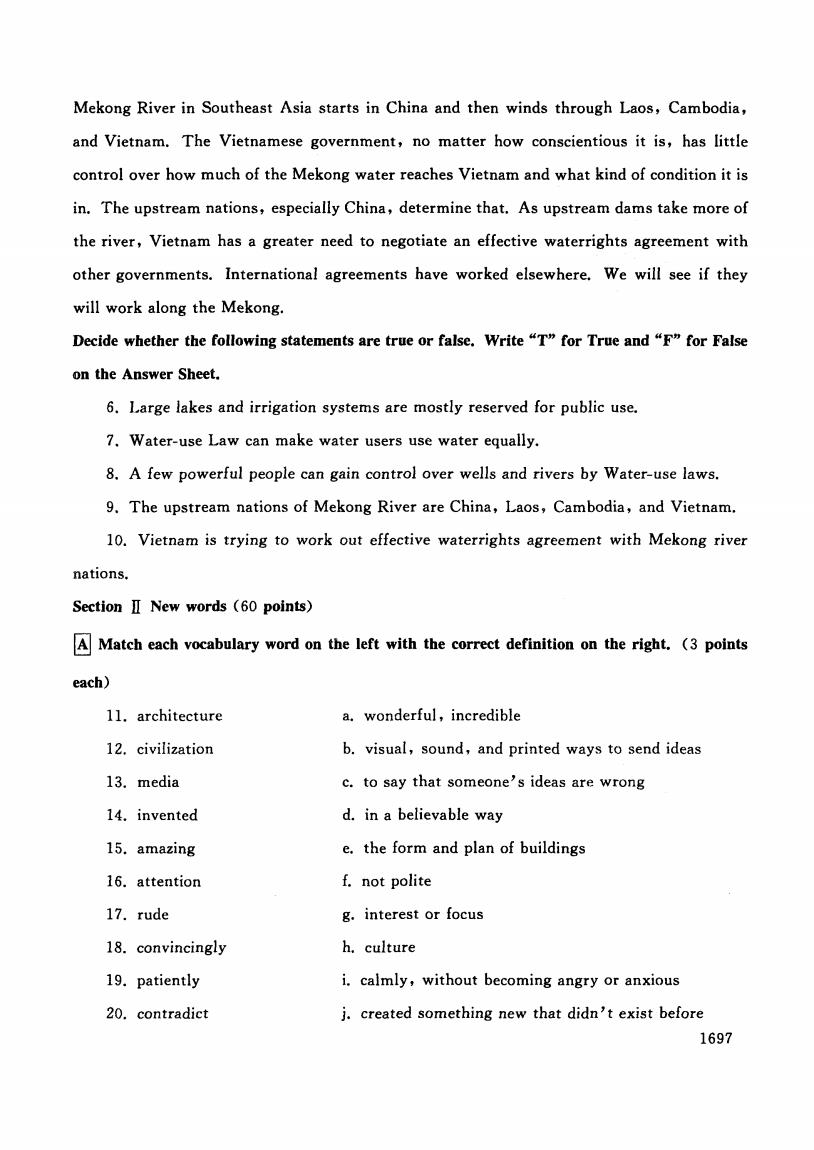
Mekong River in Southeast Asia starts in China and then winds through Laos,Cambodia, and Vietnam.The Vietnamese government,no matter how conscientious it is,has little control over how much of the Mekong water reaches Vietnam and what kind of condition it is in.The upstream nations,especially China,determine that.As upstream dams take more of the river,Vietnam has a greater need to negotiate an effective waterrights agreement with other governments.International agreements have worked elsewhere.We will see if they will work along the Mekong. Decide whether the following statements are true or false,Write“T”for True and“F”for False on the Answer Sheet. 6.Large lakes and irrigation systems are mostly reserved for public use. 7.Water-use Law can make water users use water equally. 8.A few powerful people can gain control over wells and rivers by Water-use laws. 9.The upstream nations of Mekong River are China,Laos,Cambodia,and Vietnam. 10.Vietnam is trying to work out effective waterrights agreement with Mekong river nations. Section II New words (60 points) A Match each vocabulary word on the left with the correct definition on the right.(3 points each) 11.architecture a.wonderful,incredible 12.civilization b.visual,sound,and printed ways to send ideas 13.media c.to say that someone's ideas are wrong 14.invented d.in a believable way 15.amazing e.the form and plan of buildings 16.attention f.not polite 17.rude g.interest or focus 18.convincingly h.culture 19.patiently i.calmly,without becoming angry or anxious 20.contradict j.created something new that didn't exist before 1697
Mekong River in Southeast Asia starts in China and then winds through Laos, Cambodia , and Vietnam. The Vietnamese government , no matter how conscientious it is , has little control over how much of the Mekong water reaches Vietnam and what kind of condition it is in. The upstream nations, especially China , determine that. As upstream dams take more of the river, Vietnam has a greater need to negotiate an effective waterrights agreement with other governments. International agreements have worked elsewhere. We will see if they will work along the Mekong. Decide whether the following statements are true or false. Write "T" for True and "F" for False on the Answer Sheet. 6. Large lakes and irrigation systems are mostly reserved for public use. 7. Water-use Law can make water users use water equally. 8. A few powerful people can gain control over wells and rivers by Water-use laws. 9. The upstream nations of Mekong River are China , Laos, Cambodia , and Vietnam. 10. Vietnam is trying to work out effective waterrights agreement with Mekong river natIOns. Section II New words (60 points) voca word on 伽left with 伽correct 削n阳on 帷t. (3 poi each) 11. architecture 12. civilization 13. media 14. invented 15. amazing 16. attention 17. rude 18. convincingly 19. patiently 20. contradict a. wonderful , incredible b. visual , sound , and printed ways to send ideas c. to say that someone's ideas are wrong d. in a believable way e. the form and plan of buildings f. not polite g. interest or focus h. culture i. calmly , without becoming angry or anxious j. created something new that didn't exist before 1697
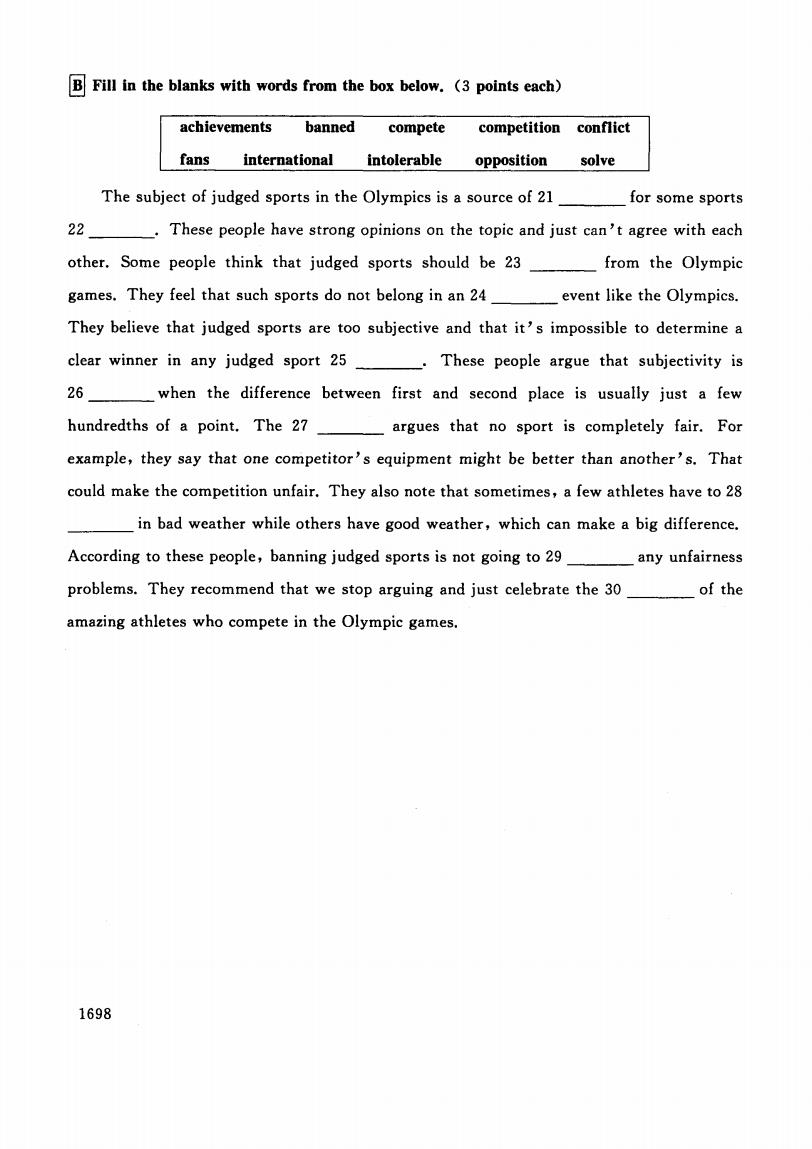
B Fill in the blanks with words from the box below.(3 points each) achievements banned compete competition conflict fans international intolerable opposition solve The subject of judged sports in the Olympics is a source of 21 for some sports 22 These people have strong opinions on the topic and just can't agree with each other.Some people think that judged sports should be 23from the Olympic games.They feel that such sports do not belong in an 24event like the Olympics. They believe that judged sports are too subjective and that it's impossible to determine a clear winner in any judged sport 25.These people argue that subjectivity is 26 when the difference between first and second place is usually just a few hundredths of a point.The 27 、 argues that no sport is completely fair.For example,they say that one competitor's equipment might be better than another's.That could make the competition unfair.They also note that sometimes,a few athletes have to 28 in bad weather while others have good weather,which can make a big difference. According to these people,banning judged sports is not going to 29 any unfairness problems.They recommend that we stop arguing and just celebrate the 30 of the amazing athletes who compete in the Olympic games. 1698
ill in the blanks 灿words from the box below. (3 poi盹each achievements banned fans international compete intolerable competition conflict opposition solve The subject of judged sports in the Olympics is a source of 21 for some sports 22 . These people have strong opinions on the topic and just can' t agree with each other. Some people think that judged sports should be 23 from the Olympic games. They feel that such sports do not belong in an 24 一-一一 event like the Olympics. They believe that judged sports are too subjective and that it' s impossible to determine a clear winner in any judged sport 25 一一 These people argue that subjectivity is 26 when the difference between first and second place is usually just a few hundredths of a point. The 27 argues that no sport is completely fair. For example , they say that one competitor's equipment might be better than another' s. That could make the competition unfair. They also note that sometimes, a few athletes have to 28 in bad weather while others have good weather, which can make a big difference. According to these people , banning judged sports is not going to 29 any unfairness problems. They recommend that we stop arguing and just celebrate the 30 __. of the amazing athletes who compete in the Olympic games. 1698

试卷代号:1353 座位号口 中央广播电视大学2012一2013学年度第二学期“开放本科”期末考试 高级英语阅读(1)试题答题纸 2013年7月 题 号 Section I SectionⅡ 总分 分 数 得分 评卷人 Section I Reading Comprehension (40 points) A Read the passage.Then answer the questions that follow.(5 points each) 2 3 4 B Read the passage.Then answer the questions that follow.(3 points each) 6 8 9 10 得分 评卷人 Section II New Words (60 points) A Match each vocabulary word on the left with the correct definition on the right.(3 points each) 11 12 13 14 15 16 17 18 19 20 1699
试卷代号 3 5 3 座位号rn 中央广播电视大学 3学年度第二学期"开放本科"期末考试 高级英语阅读( 1)试题答题纸 2013 年7 Section I Section n 分 数 |得分|评卷人| I I I Section I Reading Comprehension (40 points) tbe passage. Then answer that follow. ( 阴in臼eaω 1 2 3 4 5 as Th,en answer the ql则ions 伽at follow. (3 points each Section n New Words (60 points) I I |得分|评卷人| I I I 7 8 9 10 each left with the correct 伽ition on the right. (3 points I 11 I 12 I 13 I 14 I 15 I 16 I 17 I 18 I 19 I 20 I I , I I I I 1 I I I I 1699
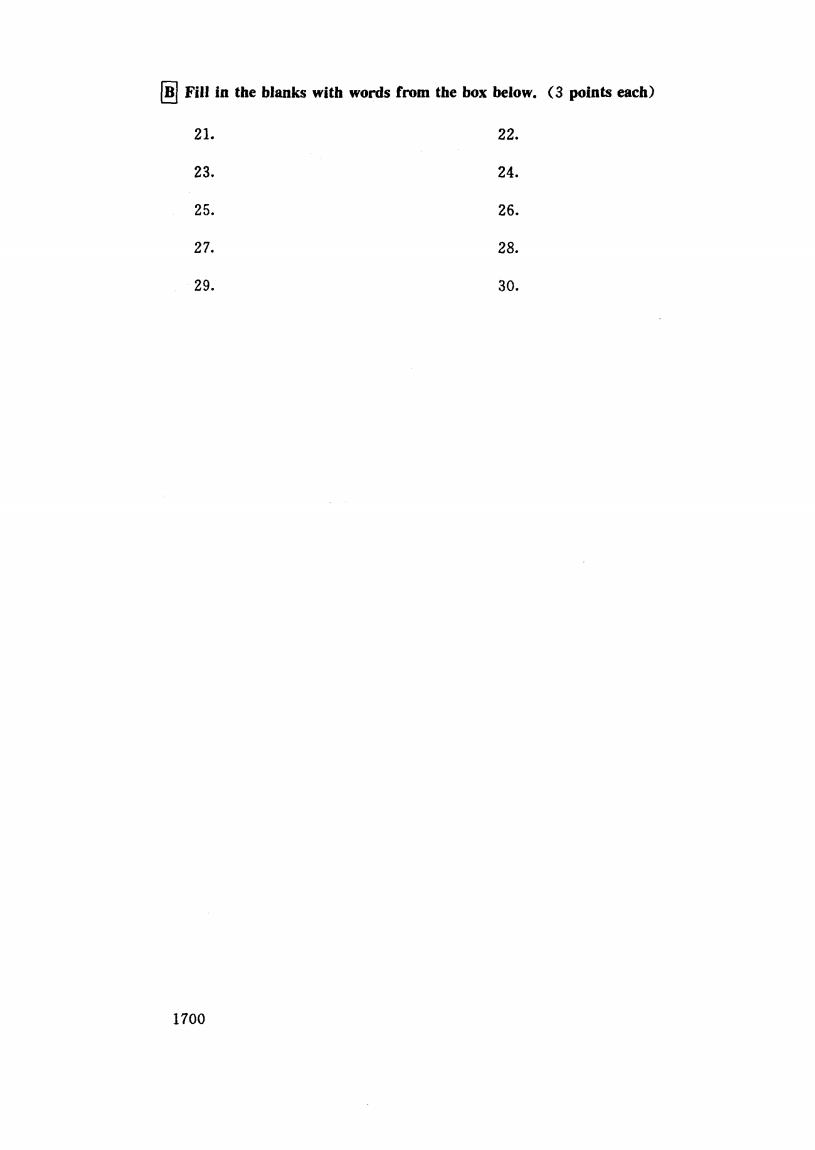
B Fill in the blanks with words from the box below.(3 points each) 21. 22. 23. 24. 25. 26. 27. 28. 29. 30. 1700
K" nvosamhu a'tw aEmm &z- x umqdnLqLqdqd [-w qa wod gmw a ,‘ w.... m ea H22222 ·-·· m-a· LU··a 1700
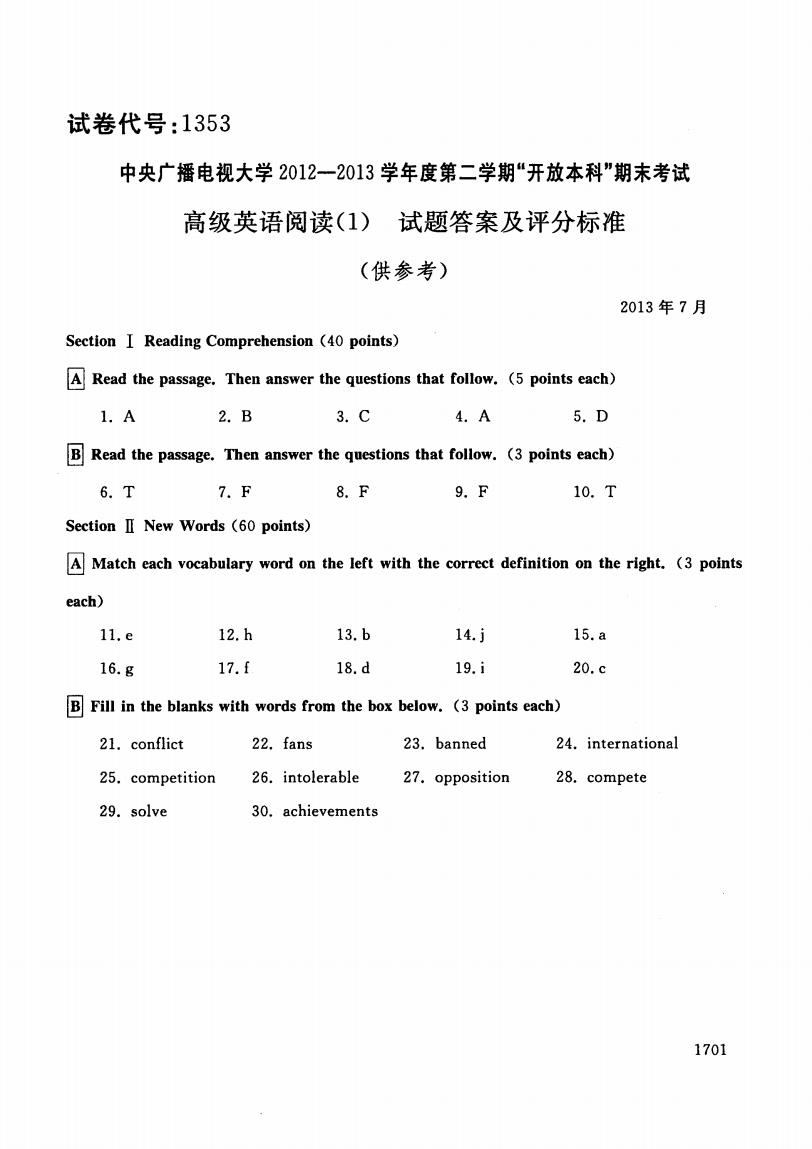
试卷代号:1353 中央广播电视大学2012一2013学年度第二学期“开放本科"期末考试 高级英语阅读(1)试题答案及评分标准 (供参考) 2013年7月 Section I Reading Comprehension(40 points) ARead the passage.Then answer the questions that follow.(5 points each) 1.A 2.B 3.C 4.A 5.D B Read the passage.Then answer the questions that follow.(3 points each) 6.T 7.F 8.F 9.F 10.T Section II New Words(60 points) A Match each vocabulary word on the left with the correct definition on the right.(3 points each) 11.e 12.h 13.b 14.j 15.a 16.g 17.f 18.d 19.i 20.c B Fill in the blanks with words from the box below.(3 points each) 21.conflict 22.fans 23.banned 24.international 25.competition 26.intolerable 27.opposition 28.compete 29.solve 30.achievements 1701
试卷代号 中央广播电视大学 3学年度第二学期"开放本科"期末考试 高级英语阅读 )试题答案及评分标准 (供参考) 2013 年7 Section I Reading Comprehension (40 points) ssag Then answer the questions that follow. (5 points eaω 1. A 2. B 3. C 4. A 5. D as Then answer the questions 伽t follow. (3 points eaω 6. T 7. F 8. F 9. F 10. T Section IT New Words (60 points) each vocabulary word on 伽left with the correct definition on the right. (3 points each) 11. e 12. h 13. b 14. j 15. a 16.g 17.f 18.d 19.i 20.c ill in the blanks 灿words from the box below. (ω3 eacl 21. conflict 22. fans 23. banned 24. international 刽5. competition 衍6. intolerable 幻7. opposition 28. ∞omp严ete 29. solve 30. achievements 1701